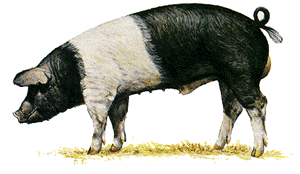Saddleback Swine
The Saddleback has the striking color marking of a white belt on a black body. However, the coloring of the modern day Saddleback still varies through the entire existence of the breed. Unfortunately, the belt is a marking of low heritability. Littermate marking may range from a very wide white belt that covers almost the entire body to the opposite extreme where there is little white. The ears of the breed are drooped.
 The Saddleback originated from the amalgamation of the Essex and Wessex breeds in
England. The Wessex Saddleback came from Dorsetshire, England, while the Essex came
from the county that gave the breed its name. Prior to 1820, both had contributed
to the swine of Hampshire which were apparently the ancestors of the American Hampshire
breed. How much of the crossing took place or how well the breed was established before
foundation stock of the Hampshire was exported to the United States, between 1825
and 1829, is not known. Youatt and Martin' reported swine very similar to the American
Hampshire in England during 1855.
The Saddleback originated from the amalgamation of the Essex and Wessex breeds in
England. The Wessex Saddleback came from Dorsetshire, England, while the Essex came
from the county that gave the breed its name. Prior to 1820, both had contributed
to the swine of Hampshire which were apparently the ancestors of the American Hampshire
breed. How much of the crossing took place or how well the breed was established before
foundation stock of the Hampshire was exported to the United States, between 1825
and 1829, is not known. Youatt and Martin' reported swine very similar to the American
Hampshire in England during 1855.
A strong point of the Saddleback breed in England in its reputation as a mother sow. The sow have large litters and are said to be excellent milkers. The breed is reputed to be hardy with good grazing characteristics suited to outdoor production systems. It has been used as a cross with white breeds to produce breeding sows for commercial swine production.
The breed has seen some commercial use where hybrid vigor is sought. Their popularity seems to be in excess of the numbers that are registered. So, as with many other breeds, in registered grade stock is often used in cross breeding. The increasing usage of the breed in crossing parallels the reputation of the Hampshire in American for crossbreeding and for rotational breeding programs. The similarity of the Saddleback and Hampshire in so many ways does indicate the former must have given more to the latter than a striking color pattern.
References
Briggs, Hilton M. 1983. International Pig Breed Encyclopedia. Elanco Animal Health
